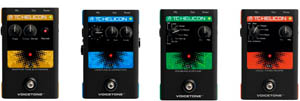TC-Helicon VoiceTone Singles vocal effects boxes let singers in on the fun
(Dave Molter | Posted 2011-04-02)

Not so very long ago, when you talked effects for singers, you were limited to Robert Plant's twirling of a microphone or Steven Tyler's sexual antics with microphone stands. If a band could afford a soundman, the crowd may be treated to a bit of Echoplex or Ian Anderson's "Aqualung"-like filtering for vocals. Occasionally, a singer might get adventurous and run vocals through a guitar phaser or reverb, but effects boxes designed just for vocalists just didn't exist. Then effects manufacturers woke up.
TC-Helicon pioneered vocal effects boxes with multi-effects devices such as the Voicetone Create, and it wasn't long before Boss and few more manufacturers entered the market. In fact, it was hard to walk more than 30 feet at Summer NAMM in Nashville without hearing a solo singer/guitarist crooning through some kind of vocal effects unit that added harmony, auto-tuning, reverb and more.
But it was TC-Helicon that took the market one step further late in 2010 with the introduction of the VoiceTone Singles effects boxes. MGR put the four VT Singles boxes through their paces recently, and our singers couldn't have been happier with the results.
Four on the floor
VoiceTone Singles come in four flavors:
VoiceTone T1 - Adaptive EQ and Dynamics ($129 USD street)
VoiceTone C1 – HardTune & Correction ($169 USD street)
VoiceTone D1 – Doubling & Detune ($149 USD street)
VoiceTone R1 – Vocal Tuned Reverb ($149 USD street)
Singers are free to mix and match the units, which feature a standard XLR input to a studio-quality microphone preamp and a balanced out to go directly to a PA or an amplifier designed to double as a small PA system for solo artists. The Singles have a standard stompbox in/out switch but can also be controlled by TC Helicon's MP-75 series microphone, which features a switch to turn the Singles on and off. The pedals also have a USB connection that allows users to hook up to TC VoiceSupport for software updates, tips, tricks and sample settings, and each pedal includes an AC power adapter.
Supremely adaptive
MGR used the Singles in a club setting using a common rhythm section but five different singers: a male who cut his teeth on metal and had a bit of a, shall we say, dynamics problem; a more blues-oriented singer with plenty of grit to his sound; and three females singers who ran the gamut from Sade sweet to Grace Potter and the Nocturnals raunchy.
As described above, our metal maven likes to perform full-out and peppered his vocals with some sludge metal gutteral utterings as well as some screams that would have made Robert Plant proud. Normally, a soundman would have to ride this singer's channel non-stop to avoid overload. But. connected between this singer's microphone and the snake, the VoiceTone T1 Adaptive EQ and Dynamics did a masterful job of not only keeping his vocals to manageable dynamic level, but also of giving them a very even tone. From croak to scream, the vocals sounded surprisingly even, yet still passionate.
Next up we installed the VoiceTone C1 HardTune & Correction on our Sade-clone female singer, who requested that we channel Cher's AutoTune vibe. This we accomplished with ease by tweaking what we quickly came to call the pedal's "gender-bender" knob and using Hard Tune setting. A more subtle tuning correction effect is available by turning the tuning knob more counterclockwise, but in our case, we wanted over-the-top, and the VT supplied it.
By far the most fun we had with any of the Singles came when we plugged in the VoiceTone D1 Doubling & Detune. The D1 had us lining up to try our hand at its various settings, all of them based on doubling effect that has the added benefit of TC's research into the fine art of making one voice sound like two or more. Back in the 1970s, my band had one of the first vocal doubling units, and it was always a crapshoot to find a setting that added depth and thickness without being obvious. TC seems to have solved that problem with the D1, which includes not only standard double-tracking effects but also Octave Up, Octave Down, and a very cool Shout setting that must be heard to be appreciated.
Last up on the test platform was our old-school bluesman, who insisted that he had no use for AutoTune, doubling or EQ. "Just give me reverb!" he demanded. And the VoiceTone R1 Vocal Tuned Reverb delivered. We all know what reverb sounds like, but the R1 took 'verb to new level with "Vocal Tuned Reverb," which optimizes eight preset reverbs for use on voice. Included verbs are Hall, Plate,
Theater, Club, Room, Studio, Ambience and Arena. If you can't find your perfect reverb in the R1, chances are it doesn't exist.
The Bottom Line
With the VoiceTone Singles line of stompbox effects pedals for vocalists, TC Helicon has hit a home run. Any singer -- from a rock band frontman who wants to experiment and control his own sound to a solo songbird who can't afford the luxury of a soundman to add effects to her voice -- will love these units. They're easy to use, rugged, yet attractive and affordable. But in this case, hearing is believing. We encourage you to visit the VoiceTone Singles website or a great NAMM video demo to hear them for yourself.
Up to four VoiceTone Singles can be connected together with the TC Helicon VoiceTone Singles Connection Kit to form the ultimate vocal processing chain. The kit includes a 12V power supply, 3 x DC daisy-chaining connectors, 3 x short XLR cables.
Dave Molter Is MusicGearReview's managing editor and Bass Guitars Editor. He has played professionally since 1965.



